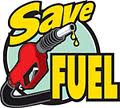 Petroleum accounts for 40% of the worlds’ energy consumption. In these days of high inflation, what better way to be eco-friendly than to increase our car’s mileage.
Petroleum accounts for 40% of the worlds’ energy consumption. In these days of high inflation, what better way to be eco-friendly than to increase our car’s mileage.
Driving skills
- The most influential factor when saving fuel is the mood you’re in. Aggressive driving reduces your mileage by 33% on the highway and 5-10% in the city! Allow more time for your journey (leave a few minutes earlier) and you’ll be amazed how much fuel you can save.
- Most of us just race off from a traffic light without giving it much thought at all. A driver can reduce fuel consumption by up to 10% by anticipating traffic conditions ahead and adjusting the speed accordingly. It takes up to six times more fuel to move a car from a dead stop than it does for one moving at just a few km/h.
- Consumption reduction is 20%-25% by avoiding sudden unnecessary braking and rapid acceleration. Not to mention how much damage it does to the engine internals.
- Stay in your lane! Studies have shown that lane changing does not significantly reduce your travel time, but increases fuel consumption.
- Only about 20% of the petrol or diesel is converted to motion, the rest is wasted in heat, vibration, noise. So the time spent idling your car while waiting burns fuel and costs crores. You may use a slightly longer route which has fewer stops. Also, on traffic signals, switch off the vehicle only if it is a long stop, for instance, for a minute or more.
- You should change up or down through the gears as soon as practical. And don’t use gears to slow down the car.
- With today’s cars, it is not necessary to prime the engine first by pumping the accelerator pedal repeatedly. However, avoid sudden acceleration before the engine has warmed up sufficiently.
- Avoiding high speeds on open roads results in safer driving and better fuel economy. However, this should not lead one to conclude that the lower the speed, the better the fuel economy. The fuel consumption of an average car is best at speeds of 50-90 km/h.
 Car maintenance
Car maintenance
- Sticking to the motor oil that’s recommended by your car’s manufacturer can increase fuel efficiency by up to 2%. Also, petrol additives clog fuel filters and stay at the bottom of the tank, so can be avoided.
- Tires lose about 1-2 psi pressure per month due to air loss caused by the tires hitting potholes and bumps. Deflated tires will also cause the tires to wear out prematurely. Under-inflated tires require more energy to roll and decrease a car’s fuel efficiency. Driving with properly-inflated tires can improve fuel economy by 3%. Flat wheel covers increase mileage by 1 to 3%. Tires with thick width will improve the handling of your car, but it will also increase your car’s fuel consumption.
- Keep your car in good shape. Routine maintenance on your car’s engine can increase its fuel efficiency and even extend its life. Just giving your engine a tune-up can improve mileage by 4% and often much more.
- Clogged air filters can damage your engine and decrease fuel efficiency, by restricting airflow to the engine. Regularly changing the air filter will improve mileage by 10%. Even better: Air filters are fairly cheap.
Other fuel saving tips:
- Any unnecessary equipment or baggage in a car’s trunk can decrease its fuel efficiency by up to 2% for every 50 kg’s. Less weight, less energy for the engine to have to put into the car to make it move.
- On your next road trip, try to pack everything inside the car rather than piling it on the roof. Stashing stuff on top of the car increases drag and decreases fuel economy by 5% up to 20%!
- Whenever possible try to keep the air conditioner at the lowest level. Having it maxed out can reduce your fuel efficiency by up to 10-25% compared to having the AC turned off. However, at higher speeds, use of air conditioning is better for fuel economy than an open window.
- When filling up the tank, do not squeeze the trigger of the nozzle to a fast mode. In slow mode vapours are minimized, hence more fuel fits in the tank.
- Carpooling! Nearly 80% of people drive to work alone; about 38% drive alone in general. If your buddy works at the same place at the same time hitch a ride! Maybe it’s your turn to drive! Consumption Reduction = 50%! Travelling in public transport will also save petrol.
Other long-distance travel tips:
- Keep a well-equipped first aid kit in the car.
- Keep a mobile phone charger in the car.
- Always keep in the car, hammer to break open the window, thick nylon rope, a torch, working whistle and adequate quantity of water and food.
- Ensure wipers are working fine and the car maintenance has been done before travelling.
- In a disaster-type situation, minimize travel and reach a safe place first.
- Lower your window panes, when travelling in a water-logged area.
Compiled from various sources like the US Department of Energy (DOE) and Alliance to Save Energy, in public interest.
